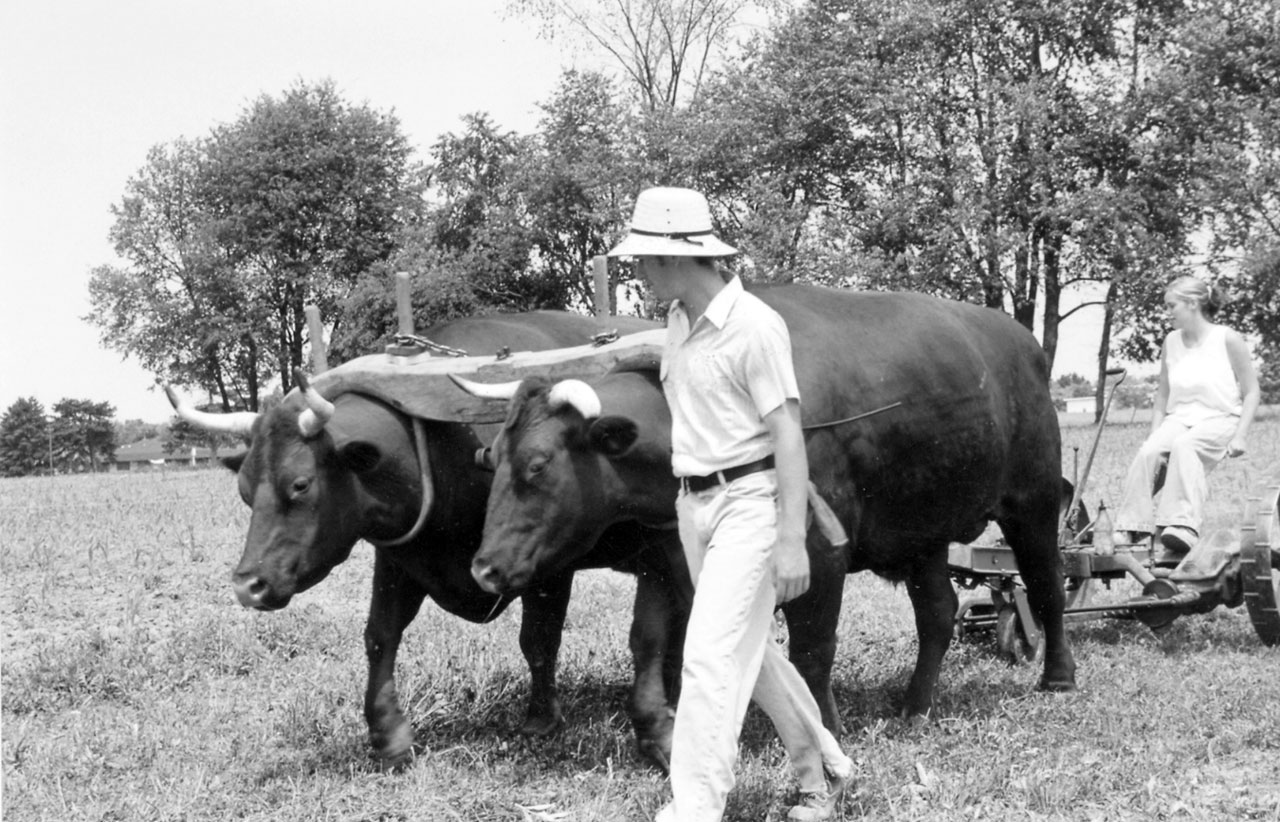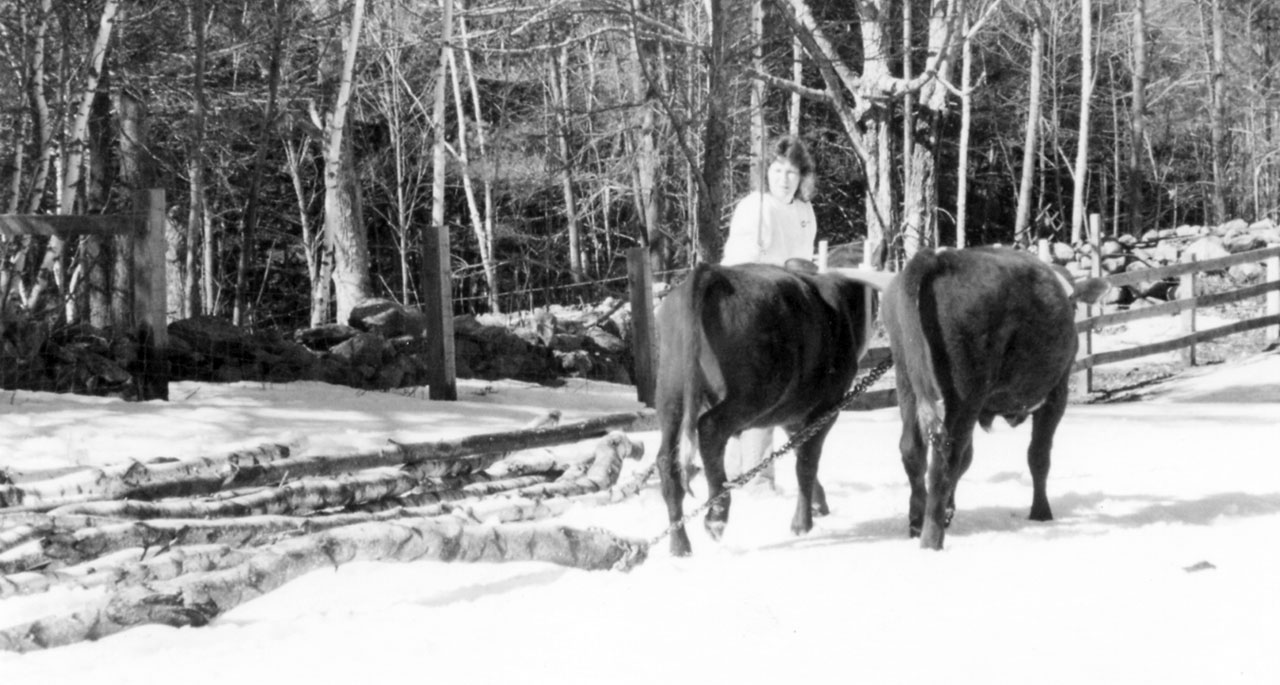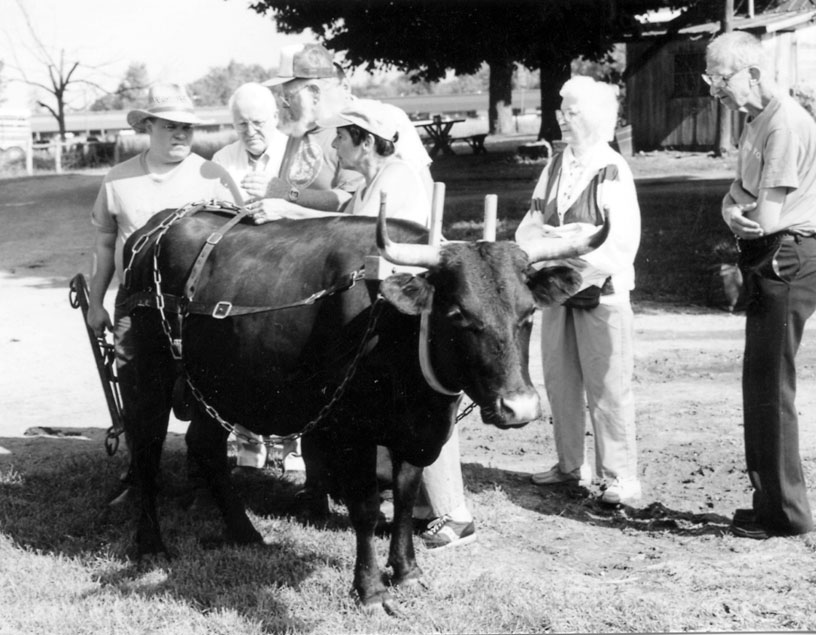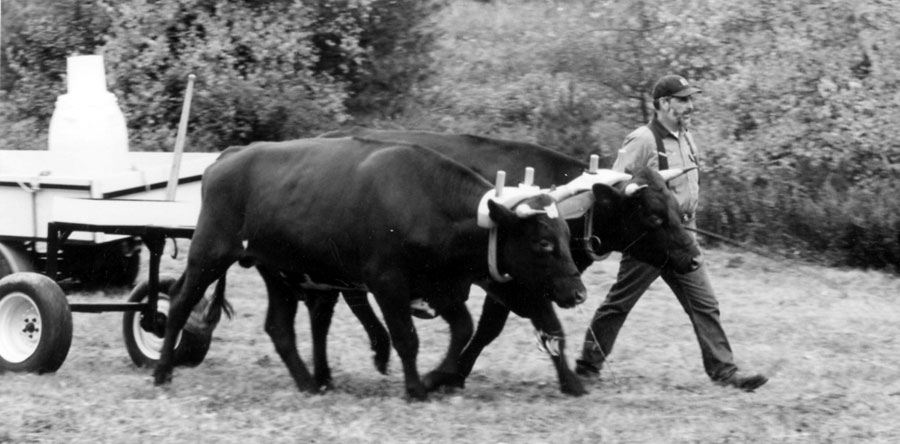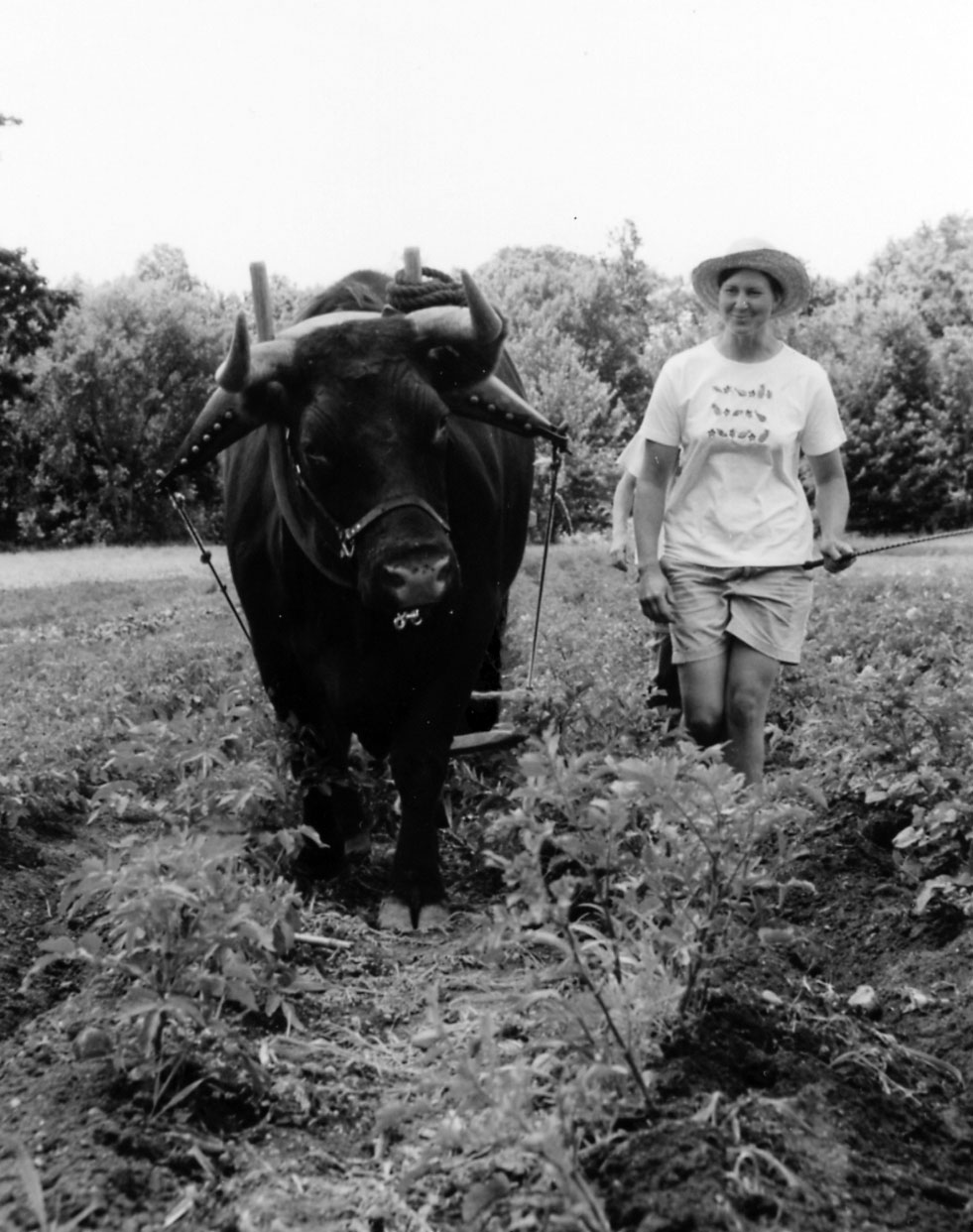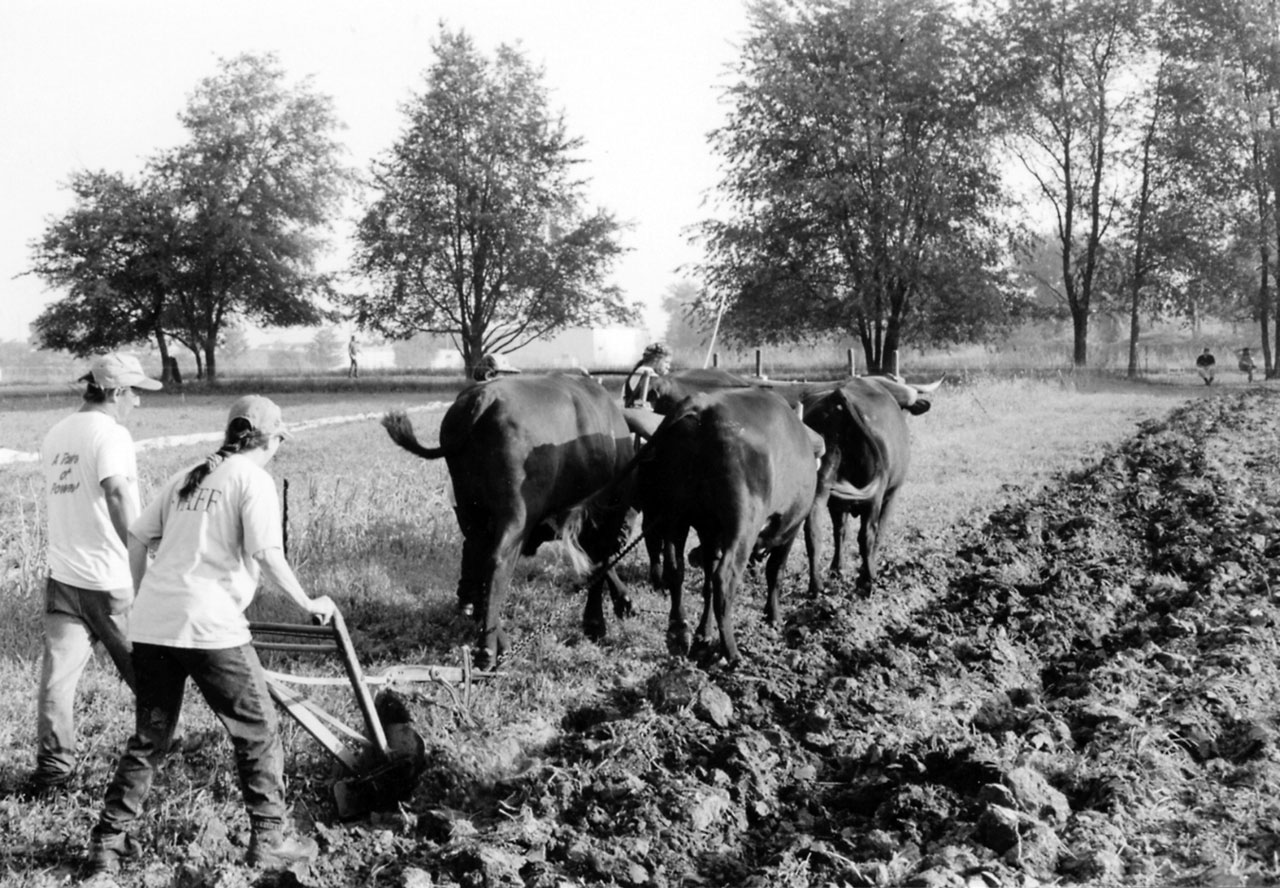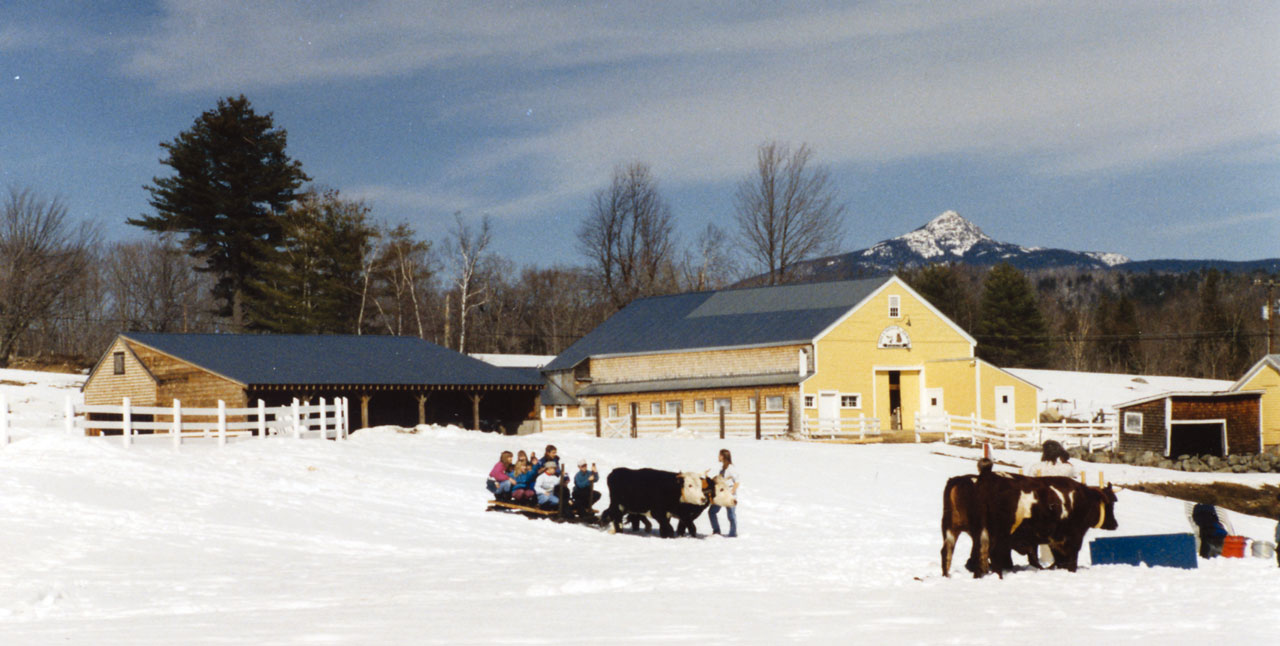Working Steers and Oxen on the Small Farm
by Tim Huppe of Farmington, NH
The number of teams of working steers and oxen being trained and used in some fashion in North America is on the rise. The present number may be the greatest in over forty years. There are several factors contributing to this increase.
For centuries, the skills of training steers for work and the craft of building yokes and related equipment was passed down from generation to generation. It was common for a young boy or girl to be responsible for the care and training of a team from calves to the age of working capability. Many farms trained a team each year, either for sale or for future replacement in their own draft program. The older, accomplished teamsters will say that no one ever taught them to train cattle; they just did it! Very little information was available in print until Dr. Drew Conroy put pen to paper. He has spent many hundreds of hours researching and writing. His books The Oxen Handbook and Oxen, A Teamsters Guide are the most definitive sources of information to date. His many articles in farm magazines go into greater depth on a variety of subjects. A complete novice can follow Conroy’s teamster guide and produce a good pair of working cattle.
Magazines such as Small Farmer’s Journal, Rural Heritage, Mother Earth News, Draft Horse Journal, and others provide us with articles telling stories of cattle working on farms, in the woods, and on exhibition, etc.
Organizations provide support at regional levels. The New England Ox Teamsters Association, the Maine Draft Horse and Ox Association, the Midwest Ox Drovers Association, the Mid-South Ox Drovers Association, the Prairie Drovers Association, and many more offer expertise and opportunity for those interested in working cattle. 4-H clubs around the country offer working steer programs and the opportunity for youth and their families to participate in their project.
Tillers International in Michigan has for many years offered workshops and internships for those seeking to learn the craft of working steers and building related equipment.
Museums and living history farms such as Colonial Williamsburg in Virginia, Howell Farm in New Jersey, Sauder Village in Ohio, Remick Farm in New Hampshire, The Farm School in Massachusetts, and the Ross Farm in Nova Scotia, just to name a few, are working cattle on a regular basis and offer opportunities for others to learn on their respective sites.
Well-organized workshops focusing on farming and logging with working cattle are now available regionally.
Equipment such as yokes, bows, logging equipment, and farm equipment is now more easily available through magazine and internet sources.
Fairs and exhibitions conduct pulling contests, log scoot classes, plowing matches, precision obstacle courses, etc. for youth and adults. These gatherings are an excellent place to learn new techniques, exchange information, and purchase equipment and cattle. These competitions are one reason the working cattle numbers are on the increase.
ON THE FARM
Training cattle for draft on the farm is a work in progress. Start slow. Engaging a single animal or a pair in meaningful work is the best method for training.
An eight month old pair of calves can easily pull small diameter firewood, a small cart, or a light stoneboat. As the team grows, slowly increase the load volume while never asking them to exceed their reasonable capabilities.
There are a variety of jobs that cattle can be used for: pulling a two-wheeled cart, hauling manure to the fields or storage pile. Back them into the barn, turn-out shed or paddock. Either hand load or bucket the manure on while they wait patiently. It may take a few sessions with a helper standing by, but they will soon learn to stand in place during the loading. A good practice while training them to stand is to drive them up to and face a wall or fence. As you move along the gutter or change location in shed or paddock, simply lift your goad stick or whip and call them to you. If you have a ground driven manure spreader, all the better. The older generation of seasoned teamsters who once worked their farms with cattle will speak of spreading manure as a ‘courage builder’. “The further you go, the lighter the load. If you want to handle a pair of cattle, spread a load of manure each day.”
If you have a good pair of helping hands on the farm, teach your cattle to plow ground. Purchase a good land plow with strong handles. Seek the advice of an experienced teamster and learn the proper techniques. Attend a few plowing competitions. Take pictures, ask questions, and do a lot of listening. Most plow matches are geared toward horse teams. The basics are the same.
After the ground has been plowed, hook to a set of harrows. Install a stout pole on the draw of the harrow. Run the pole through the ring up to the stop on the pole. Fasten a chain onto the yoke ring and run it back to the hitch point on the harrow. You will be pulling the harrow by the chain and the pole will serve useful in steering, stopping, and backing. If you have a steer that has a tendency to be nervous and back chain, the pole will help overcome this problem. The likelihood of the animal backing around and stepping on the sharp discs is uncommon when a pole is in use. If you have a double gang set of harrows, unhook the rear set and work your team on the front set until they are ‘hard’ and in condition for a greater pull. If your harrows don’t have stone boxes on top, build them and pick stones while your cattle are taking a breather. This task should be like any other you perform with your cattle. Maintain a high level of performance. Be sure the equipment is in good condition. Make sure the yoke is fitting properly. Make every pull count. Keep the rows straight. Command the cattle to do what you want and see to it that they do so. Do not use old equipment that can fail. Breakdowns can cause serious trouble and injury.
You can fashion ground smoothing equipment with material from your farm. Car or truck tires cut in half and bolted together make a good drag. Chain link fence or a screen discarded from a loam or gravel processor only needs a pipe or hardwood 2 x 4 bolted across one end to keep them rigid. You will have a good piece of equipment to smooth fields, driveways, and woods roads. Don’t forget the easy to build and low cost stoneboat and mudboat. They are a must around the farm.
A single steer or ox is good draft power for cultivating row crops. Even a young steer in a single yoke can pull a cultivator for long periods of time. Begin the training by having someone halter lead the steer while another tends the handles of the cultivator. As the steer becomes accustomed to walking between the crop rows, attach a long lead to the halter and have the helper walk either well ahead of the animal or a few rows to the left of the animal. It won’t be long before the steer will be cultivating by the command of the implement tender. It would be advisable to put a nose basket on the steer or ox while performing garden work. It will be much easier to keep his attention and minimize crop damage.
Haying with cattle can be an enjoyable job. Most horse drawn mowers are, or can be geared to work efficiently at the walking speed of a pair of cattle. Ground driven hay tedders and rakes can either be drawn directly using a pole or if they are fitted with tractor draw bars, they can be pulled behind a light weight forecart. The hay can either be rolled into a windrow using a side delivery rake and picked up with a ground driven hay loader or can be gathered with a dump rake and hand loaded onto a wagon. Picking up loose hay and loading it onto a wagon drawn by a pair of cattle is a pleasure. As you walk to the next pile to be loaded, you can call them forward into place. Again, be sure to use nose baskets during this task.
Once you have gotten the loaded wagon to the barn, back the wagon to the mow. If the team hesitates to back the wagon because of an incline or the weight of the load, unhook them from the pole. Turn them around facing the load, hooking them to the pole, and push the load into the barn. You may want to practice this technique in an open area before performing the actual task.
The use of breechings while hauling wheeled vehicles offers advantages. There is less tongue slap when the cattle are tight within the rigging and the cattle will back great loads with ease and confidence.
For those making the large round bales, there are now large round bale movers available for use with oxen or horses.
IN THE WOODS
It may well be the value of working steers and oxen in the North American forests that has kept the craft alive until this day. The slow steady pace of these strong animals makes them well-suited for hauling logs and firewood. Their cloven hooves give them the ability to work in rough terrain. Shoeing cattle is an option but most often is not necessary.
Harvesting wood with cattle can be very simple and low in cost. A stout ox chain and choker is all the equipment that is needed to pull logs and firewood. A properly swamped (cleared of brush and debris) woods trail allows the team to draw the load out easily and minimizes hang-ups and chance of injury. If the saw logs are being harvested, a logging scoot is often employed. Rolling the logs up onto the bunks of a two runner scoot keeps them free of dirt. A clean log is worth more to a sawmill, particularly those sawmills that do not have debarking capabilities. Another feature of the scoot is the large capacity for cut-to-length logs. The scoot has clearance to pass over rocks and stumps. It has a built-in flexibility making it more maneuverable and stronger than rigid runner sleds. Great loads can be hauled with a scoot, particularly on snowy trails. A rack can be bolted to the top of the bunks for hauling 4’ firewood. A planed deck with sides can be fastened to the bunks for hauling stove length wood.
Many designs of two-wheeled forecarts are available. The forecart is great for hauling tree length saw logs and firewood. Some forecarts have mechanisms for lifting the butt end of the log off the ground, making the log easier to haul.
Other forecarts are built arch style. The arch is backed over the log. The choker chain is fastened to a fixed hook on the cart. As the team moves forward the butt end of the log is lifted several inches from the ground. Both methods work fine and keep the log much cleaner than if it had been twitched out.
Go devils, tongs, and double runner bob sleds can also be used very effectively in hauling wood.
Begin when your calves are still young, conditioning them to the noise of a chainsaw, the sound of falling trees, and the sound of heavy motorized equipment. Even if you are not working them that day, bring them into the woods and tie them unyoked to a tree. Give them a little hay and let them relax while listening to the noises of the woods operation.
Again, it is meaningful work that best trains the team to be good working cattle.
For those of you who are fortunate enough to own or have access to a sugar bush, you will find great satisfaction in hauling maple sap with your cattle. Sap hauling equipment can be as simple as a food grade plastic barrel mounted on a stoneboat to the traditional galvanized sap hauling tub fixed to a scoot or sled. The cattle handle themselves very well through water and mud holes. Their v-plow shaped front end and quiet temperament make them well suited for traveling through deep snow. And again, they do not need to be shod to do this work efficiently. The sliding yoke was developed for just this type of work. The action of a sliding yoke was designed to allow the cattle to move laterally so they could walk in the tracks of the scoot or sled runners. The mechanism of the yoke demands that the cattle’s neck pieces move in or out at the same time and the same distance. This assures that one ox did not get advantage over the other. This style of yoke also proves valuable while maneuvering the team through densely wooded areas.
It is a source of great pride and satisfaction to work a well-trained pair of cattle in the sugar bush. Walk to the next maple tree and call your team up. They will stand patiently while you pour the sap in the tank and then onto the next tree. After they get to know the sled road, you may be able to point them to the sap house, hop on the sled and let them go.
There are uses for steers and oxen that can add cash income for the farm. Hauling Christmas trees from plantation to parking lots is one example. Families enjoy the experience of searching for the right tree. The cattle make the event and the memory even better.
Contact your local utilities and let them know you have well-trained oxen for hire. It is not uncommon for electric power and telephone companies to hire draft animals to pull cable through remote areas and on islands.
I have touched upon many of the uses for working cattle and there are many more. If you have put the time into training a pair of working cattle, make time to use them for meaningful work and enjoyment. Remember, every farm needs a team!







